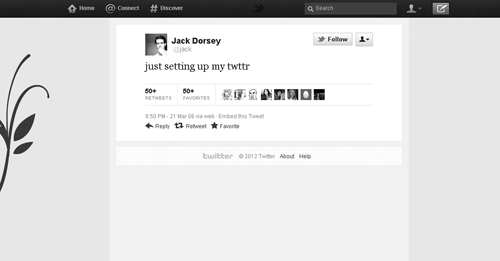How They Started (17 page)
Authors: David Lester

Unsurprisingly, funds soon ran out. The small staff continued without pay for weeks but eventually staged a mass walkout that included Hourihan. Evan ran the company solo until securing an investment from VisiCalc creator Dan Bricklin in April 2001, after Bricklin learned of Blogger’s woes from a post on Evan’s blog,
Evhead
. The staff was rehired, and Blogger’s software was rewritten so that it could be licensed to other companies.
In 2002, Evan’s next-door neighbor Noah Glass introduced himself after spotting the Blogger logo on Evan’s computer monitor. Noah’s startup, Listen Lab, was working on a way to post audio recordings on Blogger, a feature Evan added as Audioblogger.
Google acquired Blogger for an undisclosed sum in 2003. Evan spent about a year overseeing Blogger at Google before leaving in 2004 to create a new startup with Noah.
Biz Stone studied writing at Northeastern University and the arts at the University of Massachusetts Boston, near his hometown of Wellesley, but he lasted just a year at each institution before dropping out. He worked as a designer for publisher Little, Brown and Company for three years before getting the entrepreneurial urge.
He launched the free journaling service Xanga in 1999. When Blogger’s paid version came out, Xanga licensed it and Evan and Biz formed a long-distance friendship. In 2001, Biz left Xanga (which continues to operate today), and when Google purchased Blogger, he was recruited by Evan.
Evan and Noah saw how difficult it was to find and organize podcasts. In early 2005, they launched a startup designed to solve this problem. They called it Odeo.
Evan’s Blogger success made it easy to find investors. Odeo quickly raised $5 million from Charles River Ventures and an A-list of angel investors including Evan’s former boss Tim O’Reilly and Google investor Ron Conway.
Two early Odeo hires were Biz and Jack. Unfortunately, there was soon a rather large fly in Odeo’s ointment: in March 2006, Apple’s iTunes podcasting service launched and appeared certain to dominate the market. Moreover, Odeo’s technology proved difficult to execute. The 14-member team became demoralized.
Meetings were needed to discuss Odeo’s next move. Since software developers tend to work remotely and keep odd hours, getting together wasn’t always easy. Staffers were constantly being messaged or emailed to ask: “What are you doing?”
This problem rang a bell with Jack. He dug out his old sketch of Stat.us.
At a playground near Odeo’s offices in San Francisco’s South Park neighborhood, Jack pitched the Odeo execs. They debated the merits of a Web-based communication platform that would bring together email, instant messaging, and mobile-phone texting.
“He came to us with this idea: ‘What if you could share your status with your friends really easily, so that they know what you’re doing?’” Biz later recalled.
Giving himself the handle @jack, Jack created the first post on March 21, 2006: “just setting up my twttr.”

The first-ever tweet.
A team of four got the go-ahead to work on Jack’s idea. Jack, Noah, Biz and Florian Weber—a Berlin-based expert in the emerging, open source Web-development framework Ruby on Rails—worked for two weeks to create a prototype. To enable the service to work with text messaging’s 160-character limit, they set a 140-character update limit. At first, it ran on Noah’s IBM Thinkpad laptop.
The team brainstormed for a name, as Stat.us was taken. “Jitter” and “Twitch” were nominees. Noah finally came up with the name Twitter, which was originally written “twttr.” Giving himself the handle @jack, Jack created the first post on March 21, 2006: “just setting up my twttr.”
Odeo’s meeting-schedule problem was solved. More significantly, everyone found twttr fascinating and couldn’t resist sharing it with friends. By the end of the first day, there were 20 users.
Shortly afterward, Biz got an insight about twttr’s value after a hot August day spent ripping up carpeting in his stuffy apartment with his wife, Livia. Exhausted, Biz took a break and checked his twttr feed. He found Evan had posted a link to a photo of himself.
“Sipping pinot noir after a massage in Napa Valley,” was Evan’s tweet.
The sharp contrast between their weekend activities gave Biz a laugh—and he realized twttr offered a uniquely engaging way to communicate.
In short order, everyone at Odeo spent more time working on and using twttr than they spent on Odeo. A change was clearly in order. But Odeo had raised money for a podcasting product, and twttr was a text-based service. Also, twttr was an unknown quantity: “It’s too early to tell what’s there,” Evan wrote on his blog.
Evan took a highly unusual step: he gave all of the Odeo investors their money back in late 2006.
After the buyout, Evan and Biz founded a new company, Obvious Corp., which would develop twttr and find a buyer for Odeo. A key hire was former Blogger product manager Jason Goldman, who would become Twitter’s product vice president. (Odeo was purchased by startup SonicMountain for over $1 million in mid-2007.)
One of the first things Evan did after buying out the investors was to fire Noah Glass. It was the Golden Rule of business in action—Evan had the Blogger gold, and though Noah had played a key role in Twitter’s creation, the two clashed, and Evan made the rules.
Two months after launch, Twitter had just 5,000 monthly users. While a few techies were instantly hooked, others didn’t understand how it worked, or chafed at the 140-character limit. It was difficult to describe: was it microblogging? a device-agnostic message-routing system?
“For the first nine months, everyone thought we were fools,” Biz later told Terry Gross, on her national radio show
Fresh Air
. “People would say, ‘That’s the most ridiculous thing we’ve ever heard of.’ The criticism at the time was Twitter is not useful. To which Ev would say, ‘Neither is ice cream—should we ban ice cream and all joy?’ We were having fun building it.”
Besides the fun factor, what kept the team going? “From the very beginning, Ev described it as a communications platform that had revolutionary potential,” says early employee Jason Stirman, who was Twitter’s engineering manager. “It was this simple little website that kept breaking, and people were posting what they had for breakfast, but he had a vision for this thing, even in its infancy.”
The original twttr site—which boasted a green-and-white color scheme—was replaced in the fall with a blue color scheme and revamped name: Twitter. A year after it was created, in March 2007, Twitter had 20,000 users.
“For the first nine months, everyone thought we were fools. People would say, ‘That’s the most ridiculous thing we’ve ever heard of.’”
Following Evan’s Blogger model, Twitter was free for users. The company philosophy: build value before seeking profit. All energy went to keeping the site running and users happy. The company supported two important features created by Twitter users: the hashtag (#), enabling users to track popular or “trending” topics, and the forwarding “retweet” button.

Twitter’s iconic bird logo.
To grow its subscriber base, the Twitter team made plans to attend the Austin music and technology conference South by Southwest (better known as SXSW). The previous year, a competing mobile-texting service—Google-owned Dodgeball—had won Best Product of SXSW. In a risky move, Evan and Biz would face down their better-funded competitor before SXSW’s tech-savvy audience of more than 100,000.
Twitter’s marketing plan was to install two large, high-definition plasma-screen monitors in the Austin Convention Center hallways and display attendees’ Twitter updates. There would also be T-shirts emblazoned with the faux status update “wearing my twitter shirt.”
Initially, the monitors didn’t work, and Biz and Evan sweated through much of Friday night fixing them. Saturday morning, Twitter’s server in San Francisco crashed. Then, finally, the screens worked. Attendees stopped to gawk at the message scroll—then chose which sessions to attend based on what they read. Many presenters began their sessions by announcing their Twitter handles. Attendees live-tweeted about what they heard.
In a risky move, Evan and Biz would face down their better-funded competitor before SXSW’s tech-savvy audience of more than 100,000.
But Twitter made its biggest impact at night. Crowds turned like a flock of birds in the Austin streets as mobile-phone users read tweets directing them to the hottest venues and away from dull events.
Twitter was doing exactly what Evan envisioned. “It was the first time people were able to coordinate in real time,” Biz recalled later. “This was spine-tingling stuff for us.”
Stirman recalls, “SXSW was fertile ground for this product. You had all these tech people in the city without good ways to communicate with each other, especially at night. They had this ‘aha’ moment—Twitter
is
useful.”
Twitter won Best New Product of SXSW 2007 and users tripled to 60,000. The team returned home to spin Twitter out of Obvious and incorporate it as Twitter Inc. By year-end, Twitter had 200,000 users. Twitter also captured the attention of the media and influential tech bloggers. It quickly permeated pop culture: in the fall, the forensic techs of
CSI
would solve a crime after following a tweeted clue.
Investors took note. In July 2007, Twitter landed $5 million in venture-capital funding led by former Odeo investor Charles River Ventures. Other funders included Union Square Ventures, Netscape co-founder Marc Andreessen, Ron Conway, and Feedburner creator Dick Costolo, who’d worked at Google with Evan.
After SXSW, Twitter would experience the hockey-stick-shaped, straight-up growth curve that is the dream of every start-up entrepreneur. In March 2008, when Twitter hit 400,000 users, the company set out to completely rebuild Twitter’s technology to support the skyrocketing user base.
It didn’t work. Twitter would be down, sometimes for three days straight. The company still had only two dozen employees. Any big pop-culture or technology event—say, Apple’s Steve Jobs speaking at a conference—could cause a huge traffic spike and crash the system. Jack, Twitter’s first CEO, ceded the post to Evan.
“We weren’t ready for the number of people around the globe who would find Twitter so useful and so relevant to their daily lives,” Biz recalled in a PBS interview.
Why couldn’t Twitter fix its technical problems? It had money to hire more staff, but few engineers had both the needed expertise in Ruby on Rails and a willingness to work in Twitter’s frantic start-up environment, Stirman recalls. To top it off, the founders were picky about whom they hired. As a result, Twitter’s hiring lagged far behind its staffing needs. And by June 2008, QuantCast estimated Twitter had 700,000 monthly users.
At first, visitors attempting to access Twitter during outages saw the Twitter bird gazing sadly at a damaged robot. Biz wanted something more reassuring and purchased a graphic by Shanghai artist Yiying Lu of a whale being lifted out of the water by many birds, each pulling a rope.
Quickly dubbed the “fail whale,” the image became both an object of derision and a cult hit. The fail whale inspired a fan club, T-shirts, and at least one tattoo. The chronic technical breakdowns did not discourage potential investors, either.
“When your product is so popular your servers are crashing every day,” Stirman says, “that’s the sort of thing venture capitalists salivate over.”
In May 2008, Twitter would raise another $15 million from Union Square, Amazon founder Jeff Bezos’s Bezos Expeditions, Spark Capital, Digg founder Kevin Rose, and social media author Timothy Ferriss.
Twitter’s lack of a business plan made it the butt of jokes around Silicon Valley. Entrepreneurs created and compared lists of possible Twitter monetization schemes.
An April 2008 TechCrunch story on the sacking of two developers held responsible for the persistent outages mocked, “Mighdoll Out—Business Plan Still MIA.”
